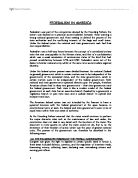Page 1 of 2
Outline how and why federalism has changed since the 1960s.
In the 1960s, the government had a creative federalist approach. The aim of Lynden Johnson’s Great society programmes was to try to eliminate poverty within the US. This in turn meant large government grants were given to states, which was seen to increase the level of interference from the federal government. Johnson also provided categorical grants instead of block grants, which meant the states had much less control over their spending. He also supplied a lot of federal aid, increasing the dependence of states on the federal government. It wasn’t just the executive increasing the role; the judiciary were also pushing the government this way, with cases such as Gideon vs. Wainwright and Miranda vs. Arizona.
Since the 1960’s the some have stated that New Federalism has been the main objective of the executive and judiciary due to the previous creative federalism. From the 1970s there was an ideological shift, with the rejection of liberal values from the 1960s. President Nixon started the development of the idea that the federal government was too powerful, and that the states needed to have more power of their local rights. He felt that the federal government should be small to promote self reliance and the American idea of ‘rugged individualism’. As a reaction to creative federalism and the great society programme, he severely reduced aid to the states, and instead of issuing categorical grants, he would give states block grants.
Uncharacteristically, President Carter, a democrat president carried on Nixon’s ideas of New Federalism. From the 60’s and before, it was clear that the democrats supported the ideas of a large federal government; however he was a governor, thus he wanted to give the states more freedom to act. He carried on Nixon’s plans of block grants, and reduced the size of the federal aid of the states to release the government of the large federal deficit.
Reagan developed Carter’s idealisms by stating “Government is not a solution to our problem, government is the problem.” He was a believer of the conservative view that federal support undermined hard work, creativity, determination and overall, managed to erode America’s Federal system. Reagan had two main policies that would create the modern form of dual federalism: Reducing federal aid to the states (in his first 2 years in office he reduced it by $18 billion), and to input the swap system in which states had to fund two poverty reducing measures whilst the federal government would supply the medicare. Reducing federal aid created a sever problem for certain states; New York was effectively made bankrupt by the reductions in federal aid and increases in what they needed to supply, and the number of Americans living in poverty rose from 29 million to 35 million. His system of swaps also had many flaws; the states found the idea very attractive but it was clear that they would not be able to carry out these programmes without severely increasing taxes or cutting benefits, and thus the scheme was rejected. The limits on his policies also showed that Dual federalism was too impractical to actually implement.
During Bush Snr’s presidency, there was a lot more emphasis on foreign policy which required the increase in size of the federal government. Also during his presidency, the Supreme Court started to make decisions that leant towards state rights; the political layout of the courts took longer to change than the executive due to life tenure of the justices meaning a President could just just swap them for more sympathetic judges.

This is a preview of the whole essay
Teacher Reviews
Here's what a teacher thought of this essay
Overall this is a very good essay. Although the essay is chronological, which is often not the best way to answer questions, here, the way the question is worded, leads towards an answer of this nature. To improve, more is needed at the start about what federalism actually is and why it is controversial. More theories as to why federalism has changed could also be included.







